4 Likes
4 Comments
Also on the rise: Auxin Solar files antidumping lawsuit against U.S. government, a Maine town bans commercial solar, and more.
https://pv-magazine-usa.com/2024/01/09/sunrise-brief-qcells-inks-its-largest-module-and-epc-agreement/
#legal, #industrial, #balance, #commercial, #systems, #pv, #installations
#Einladung / Invitation [ bitte gerne teilen / weiterleiten... PLS share]
#Ausstellung 24. April bis 13. Mai 2023, Mo-Sa 12-20h
Galerie #neurotitan
c/o Haus Schwarzenberg e.V.
Rosenthaler Straße 39
D-10178 #Berlin
Autonom spielende und interaktive Klang- und Bild-Maschinen, Installationen und großformatige Bilderserien verwandeln die #Galerie in einen Erlebnisraum. 112.5BPM ist das musikalische Tempo, in dem sich die Werke zu einem konzertanten Ganzen verbinden.
Das Haus Schwarzenberg gilt als Symbol für Freiheit und #Kunst und erscheint als eines der letzten nicht-kommerziellen Refugien in Berlins Mitte. Die Galerie neurotitan machte sich besonders durch Street Art einen Namen und gehört auch als Magnet für touristische Besucher:innen wohl zu den hochfrequenten Kunsträumen der Stadt.
112 5BPM HUMATIC co.llabs Teaser
Further Info & Updates, google doc
------------------ english
#Invitation [PLS share]
Opening April 04, 2023 6pm
#Exhibition April 24 – May 13, 2023, Mon-Sat 12-8pm
Galerie neurotitan
c/o Haus Schwarzenberg
Rosenthaler Straße 39
D-10178 Berlin
Autonomously playing and interactive #sound and image #machines, #installations and large format #picture series transform the gallery into an unique space of experience.
Haus Schwarzenberg is a symbol of freedom and #art and seems to be one of the last non- commercial refuges in Berlin-Mitte. The neurotitan gallery has made a name for itself primarily through street art and, as a magnet for tourists, is probably one of the most visited art spaces in the city.
112 5BPM HUMATIC co.llabs Teaser, googgle doc
Further Info & Updates
https://exhibition.humatic.net/
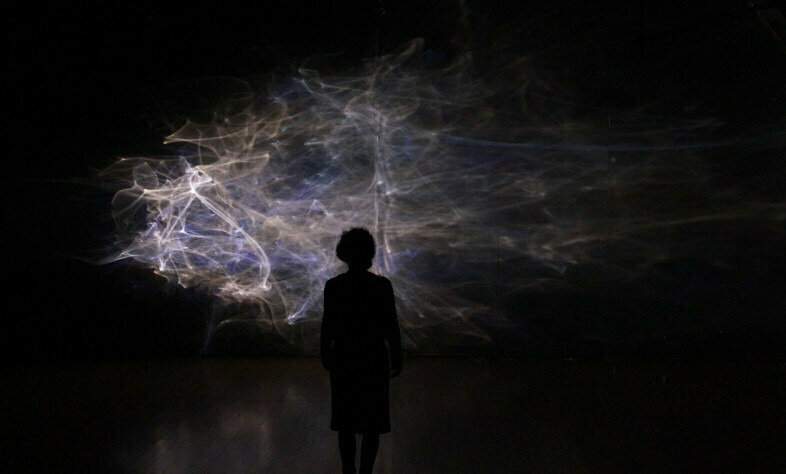
Nazanin Fakoor (Iran, 1978) a étudié les arts du théâtre à Munich et à Paris, et la scénographie à La Cambre à Bruxelles. Elle a participé à divers projets de coopération et expositions, dans des théâtres, musées et opéras du monde entier, où elle a travaillé avec Robert Wilson, Zhang Huang, Anish Kapoor et La Fura dels Baus. Ses installations visuelles et ses performances sont des approches utopiques de la réalité, à la frontière entre le reconnaissable et l'étranger, entre la vérité et l'illusion. La remise en question de l'identité est devenue une partie de son identité.
MyGrid’s new 1.5 kWh lithium iron phosphate battery system purportedly runs for more than 6,000 cycles. It uses a bidirectional charger to receive and send electricity to the grid via a wall socket.
https://www.pv-magazine.com/2023/01/10/startup-unveils-lithium-iron-phosphate-battery-for-residential-applications/
#distributed, #pv, #technology, #storage, #energy, #residential, #installations
Germany’s Fraunhofer Institute for Solar Energy and a group of heat pump manufacturers have started a project to replace gas and oil heating systems in multi-family homes with propane heat pumps featuring low-charge propane (R290) as the refrigerant.
https://www.pv-magazine.com/2022/12/28/fraunhofer-ise-to-develop-propane-heat-pumps-for-residential-homes/
#pv, #technology, #residential, #pumps, #r&d, #installations, #heat
Poland’s Energy Regulatory Office has awarded 486 MW of solar in its latest renewables auction, which was largely unsubscribed. It allocated 150 MW for installations smaller than 1 MW, with a lowest bid of PLN 0.24477 ($0.056)/kWh, and 336 MW for larger installations, with a lowest bid of PLN 0.23677/kWh.
https://www.pv-magazine.com/2022/12/22/poland-allocates-486-mw-of-solar-in-latest-renewables-auction/
#policy, #commercial, #industrial, #markets, #pv, #installations
Ranking the world’s largest producers of solar energy based on the BP Statistical Review of World Energy 2022.
https://pv-magazine-usa.com/2022/12/12/ranking-the-top-15-nations-for-solar-energy-capacity/
#sustainability, #solar, #scale, #utility, #global, #iea, #pv, #installations, #procurement
source: https://smitka.me/2022/07/01/wordpress-installer-attack-race/
The attacker uses the #Certificate Transparency Log to find new WordPress #installations. It works because you usually generate the #SSL certificate when you set up a hosting space. When the certificate is issued, the record appears in the public log.
...
It takes only 4 minutes from the certificate issue to abuse the installer (but in some cases, the attacker managed to do it in under 1 minute).
#internet #blog #security #backdoor #problem #www #web #software #install #news
Canada is set to install 500 MW of new solar in 2022, bringing its total capacity to about 5 GW, according to data from Canmet Energy. The country is expected to hit 35 GW of total solar capacity by 2050.
https://www.pv-magazine.com/2022/11/29/canada-set-to-hit-5-gw-milestone/
#utility, #policy, #markets, #pv, #residential, #installations
US researchers have installed a pilot 4.3 kW solar system at Oliktok Point, Alaska, north of the Arctic Circle. They want to determine which PV system designs and technologies are most efficient in extremely cold climates with limited sunlight.
https://www.pv-magazine.com/2022/11/23/wednesday-1-solar-for-extreme-arctic-conditions/
#commercial, #upstream, #industrial, #installations, #modules, #manufacturing, #pv
The company was selected in 2021 as part of a plan to install rooftop and brownfield solar projects and energy storage systems across over 100 sites for three dozen municipalities and school districts in Westchester County, N.Y.
https://pv-magazine-usa.com/2022/11/23/ecogy-begins-new-york-34-mw-community-solar-development-plan/
#ecogy, #westchester, #installations, #markets, #community, #solar, #procurement
SolarDuck, an offshore solar developer in the Netherlands, has been chosen to build a 5 MW floating PV project with energy storage. It aims to start operations in 2026.
https://www.pv-magazine.com/2022/11/14/offshore-wind-farm-in-north-sea-to-host-5-mw-floating-pv-plant/
#installations, #pv, #storage, #floating, #markets, #scale, #utility
Tennessee Valley Authority (TVA) approved a $216 million program to explore turning the Shawnee Fossil Plant, a closed coal ash storage location, into a utility-scale solar project.
https://pv-magazine-usa.com/2022/11/14/tva-aims-to-build-100mw-solar-installation-on-retired-coal-site-in-kentucky/
#installations, #policy, #pv, #coal, #markets, #scale, #utility
Sweden's Vattenfall has revealed plans to build a subsidy-free, large-scale solar plant along the A6 highway in the Netherlands. Construction is expected to begin in 2024, with operations to start in late 2024 or early 2025.
https://www.pv-magazine.com/2022/11/08/vattenfall-to-build-solar-array-along-dutch-highway/
#installations, #photovoltaics, #scale, #pv, #photovoltaic, #utility, #markets
The International Energy Agency (IEA) has published its "World Energy Outlook 2022" report. It expects the energy crisis triggered by Russia's invasion of Ukraine to accelerate the global energy transition.
https://www.pv-magazine.com/2022/10/28/annual-added-pv-capacity-will-more-than-quadruple-to-650-gw-in-2030-says-iea/
#policy, #highlights, #markets, #installations, #pv, #scale, #utility
The world installed around 174GW of solar PV in 2021, a 20% jump on the previous year, and is expected to deploy 260GW this year, barring any major disruptions to international trade.
https://www.pv-tech.org/the-world-installed-174gw-of-solar-in-2021-and-is-on-track-to-deploy-260gw-by-end-of-2022-iea/
#cumulative, #report, #installations, #deployment, #news, #statistics, #iea, #china
SolarApex has built what it calls the world’s largest rooftop PV array. A 140 MW project on a steelmill will help Turkish steelmaker Tosyali to shift its production to carbon-free "green steel." Chief Marketing Officer Besime Özderici says the project could be an example for other energy-intensive industries.
https://www.pv-magazine.com/2022/08/09/green-steel-powered-by-a-rooftop/
#industrial, #steel, #commercial, #pv, #installations, #inverters, #sponsored, #green
CPS Energy, serving San Antonio, is increasingly powering its operations with energy generated through the power of Texas sunlight.
https://pv-magazine-usa.com/2022/05/25/texas-utility-adds-300-mw-of-solar-to-energy-mix/
#utility, #installations, #scale, #solar, #pv
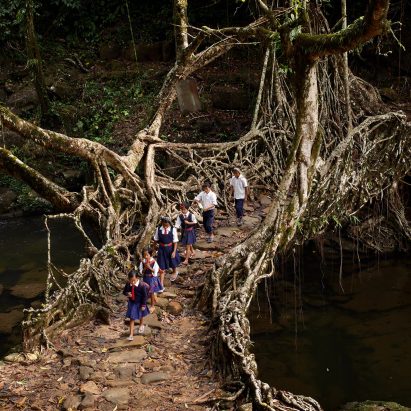
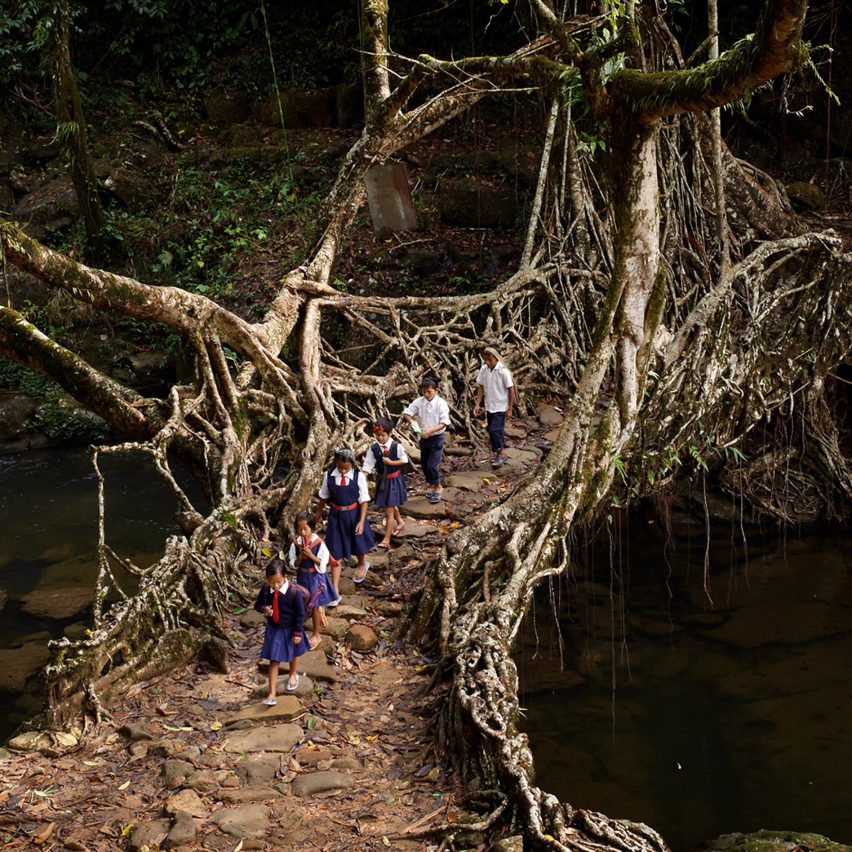
Roofs made from living trees and floating houses on reed islands are among the urban planning concepts developed by engineering studio Buro Happold in collaboration with indigenous communities as part of an installation called Symbiocene.
The project, commissioned for the exhibition Our Time on Earth at London's Barbican Centre, presents three proposals for how indigenous building technologies could be applied to cities by 2040 to make them more resilient to climate breakdown without contributing to it.
Visualised through architectural models overlaid with video projections, each concept is based on a nature-based design strategy developed by different aboriginal communities from around the world – the War Khasi of north-eastern India, the Ma'dan of southern Iraq and Bali's Subak farming cooperatives.
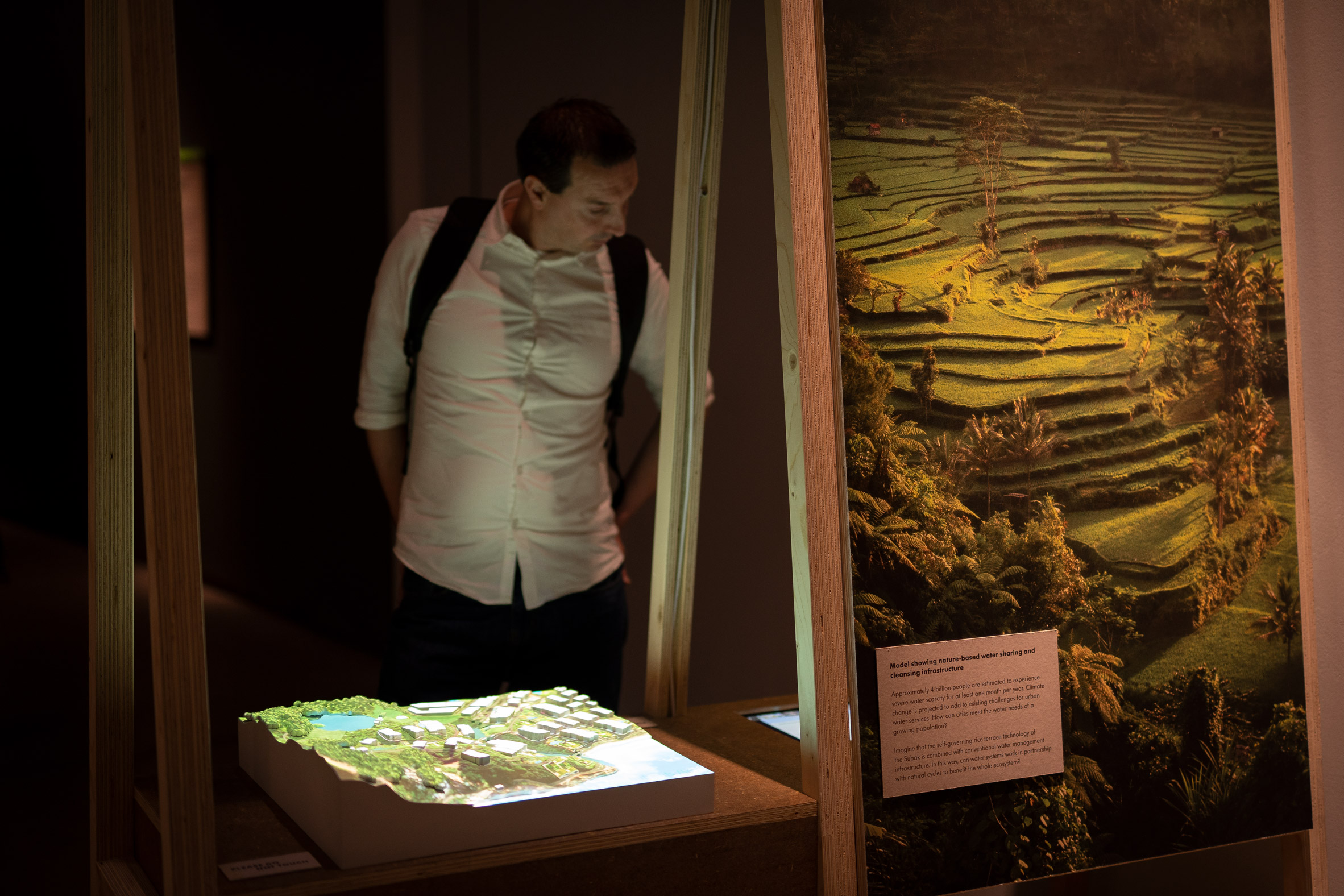 Symbiocene features models with overlaid animations (top image) by Buro Happold visualisation lead Paul Eastell (above)
Symbiocene features models with overlaid animations (top image) by Buro Happold visualisation lead Paul Eastell (above)
Through a series of workshops between the first nation builders and engineers from British firm Buro Happold, these technologies were applied to the most pressing environmental issues facing our cities – water scarcity, rising temperatures and sea levels.
"Cities all over the world are completely aware that conventional construction is very problematic in terms of the climate emergency and ongoing resilience," said Buro Happold's sustainability director Smith Mordak.
"We have solutions but we're usually looking in the wrong places. If we collaborate with indigenous communities, who have been developing technologies that are respectful of the way that ecosystems work for centuries, then we can have a vision for 2040."
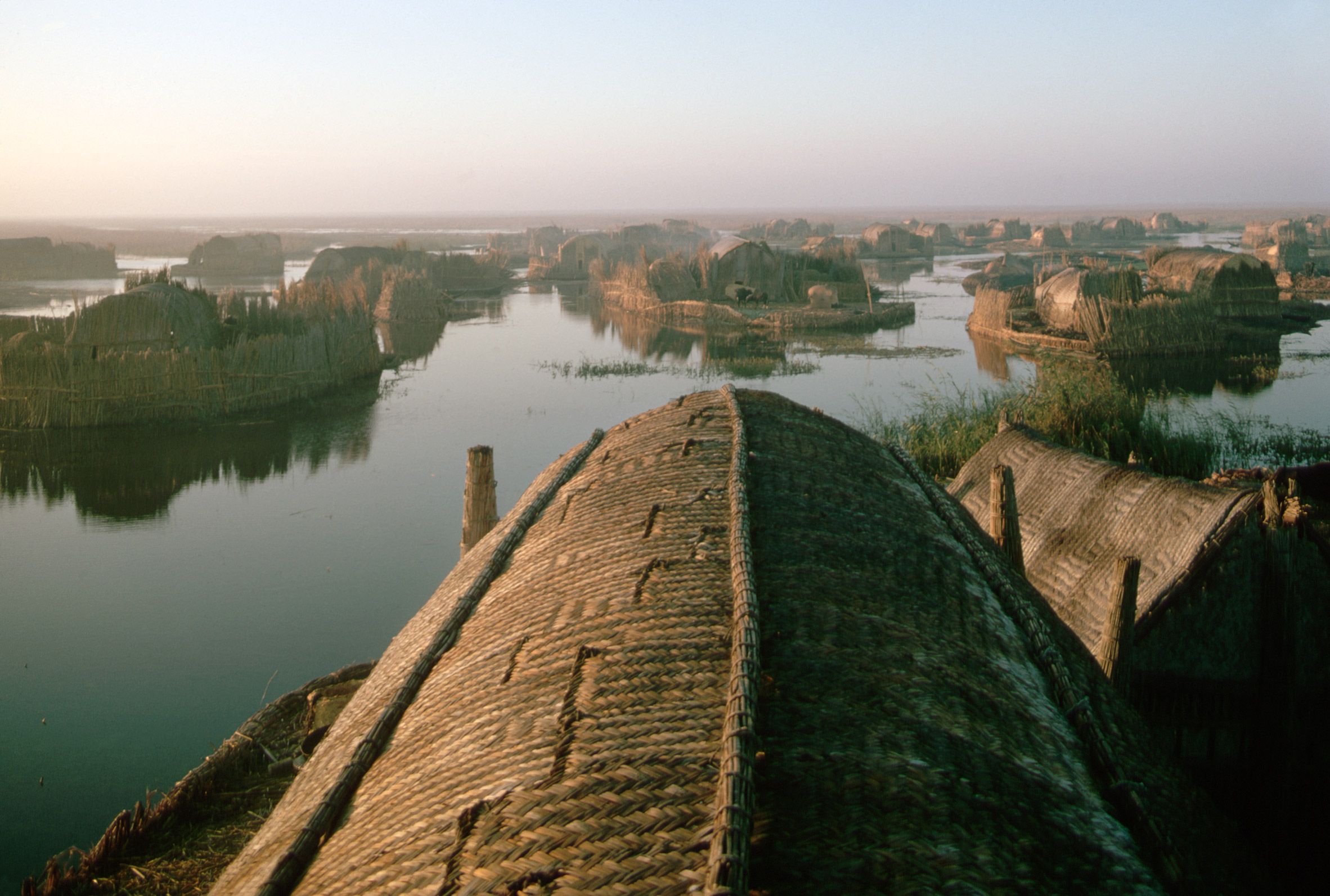 One concept is based on the Ma'dan's floating reed islands. Image courtesy of Julia Watson
One concept is based on the Ma'dan's floating reed islands. Image courtesy of Julia Watson
The first Symbiocene concept uses the floating islands made from layers of reed, on which the Ma'dan build their homes in the marshes of southern Iraq, to help retrofit coastal communities so they can survive higher sea levels.
This would involve jacking up lighter at-risk structures like single-family houses and building a structure underneath so they can be lifted onto reed islands and turned into off-grid homes with their own energy supply and composting toilets.
"When the reeds decompose, they trap air so they create these buoyant bubbles, which means that the islands are floating," Mordak told Dezeen.
"And then you can create homes on them, you can farm on them because the layers upon layers of the reeds create an island and an earth. And underneath the islands, there are these amazing bio-havens that provide habitat for water life."
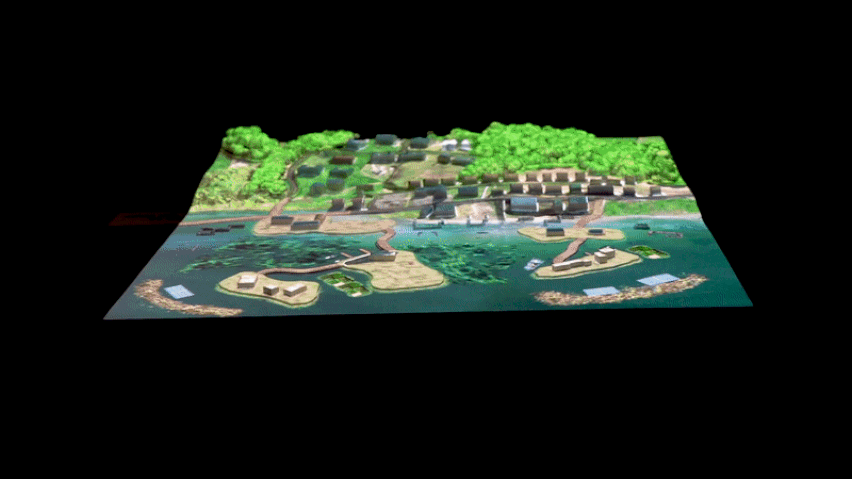 Homes could be lifted onto these floating islands to protect them from rising seas
Homes could be lifted onto these floating islands to protect them from rising seas
Using pontoon bridges, these floating islands could then be connected to existing infrastructure that has survived on higher ground as well as larger buildings raised up on stilts.
In this way, the project hopes to offer an alternative to common flood resilience proposals like barge communities, which would require considerable resources to build from scratch.
"We talk a lot about retrofitting rather than building new and we wanted to apply some of that thinking to existing waterfront communities," Mordak said.
"A lot of the ideas that have been put forward are kind of like concrete pontoons but we were trying to look at a bio-based approach."
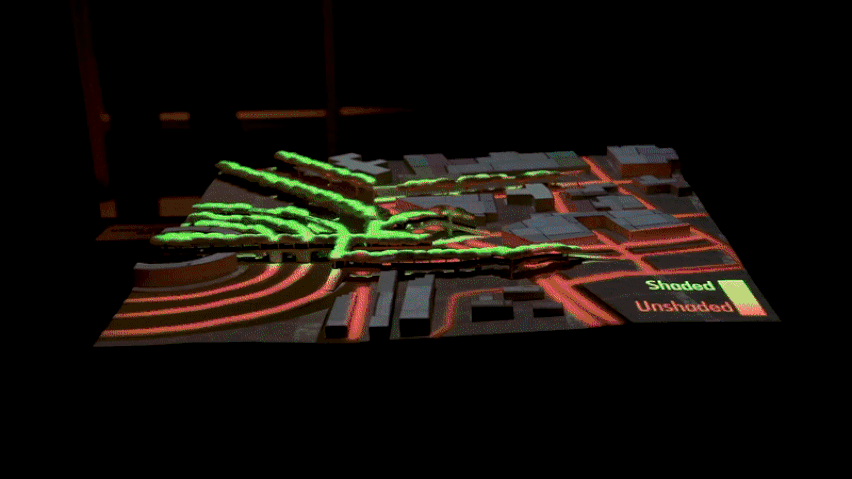 The second concept creates covered walkways from interwoven trees
The second concept creates covered walkways from interwoven trees
The second concept uses a trellising technique, which the War Khasi people use to construct bridges from living trees, to form a network of covered walkways connecting city dwellers to public transport stations.
Ficus trees with aerial roots would be planted at different levels over bamboo scaffolds and their roots and branches trained to form dense roof structures that can shield pedestrians from rising temperatures.
"This is particularly relevant in climates where it's getting hotter and actually cycling or walking for any distance is getting increasingly uncomfortable and difficult," Mordak said.
"The trees provide shade, improve air quality and lower surface temperatures through the process of evapotranspiration. That's going to make a big difference to how far people are willing and able to use those sustainable forms of transport."
[ 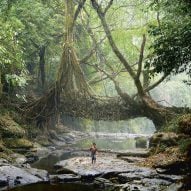
The final Symbiocene concept hopes to tackle the problem of water scarcity by moving away from a centralised "out of sight out of mind" water management system.
Instead, it proposes establishing small cooperatives at neighbourhood level, based on the Subak system used in Bali to irrigate rice terraces, which would see locals work together to distribute water according to need and encourage them to use this finite resource more responsibly
"Because water is managed at a local level with a small group of people, it's not abstract," Mordak said. "So you're going to think much more carefully about what you use, and you will be able to see the results."
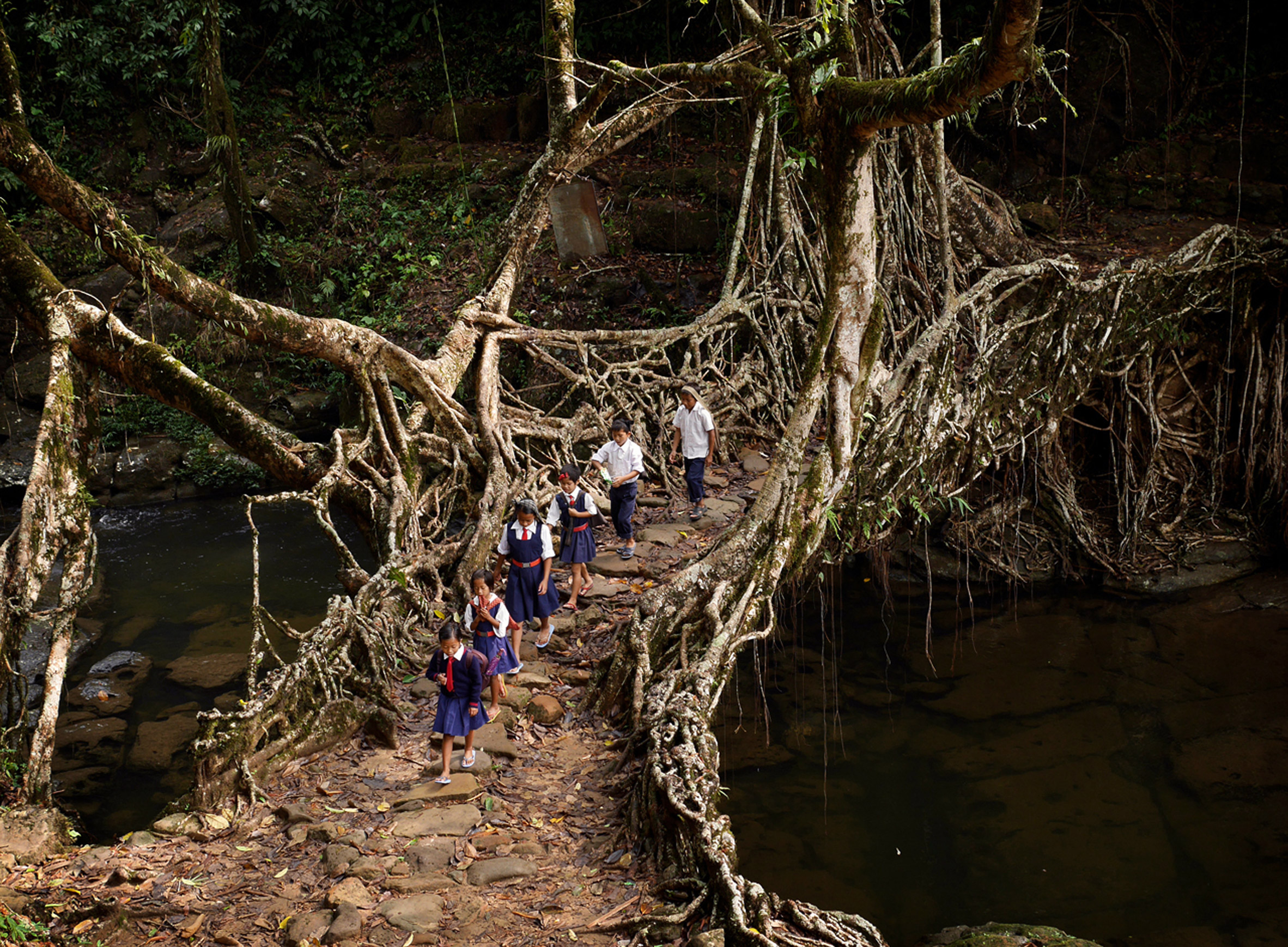 This concept is based on the living root bridges of the War Khasi. Image by Timothy Allen courtesy of Julia Watson
This concept is based on the living root bridges of the War Khasi. Image by Timothy Allen courtesy of Julia Watson
Instead of purifying all water used across a city to drinking-water quality, the concept proposes a two-step nature-based system, in which neighbourhood reed beds are used to clean water for flushing, showering and other daily activities.
From here, local cooperatives would decide how much water needs chemical purification in order to make it drinkable for the community, with any wastewater used to irrigate nearby reed beds used for growing food.
"One of the questions that came up in the conversation was, why do we in western cities shit in drinking water," Mordak said.
"Why are we using a huge amount of energy and chemicals to create very clean, drinkable water and then we're using it for things that don't need that level of purification."
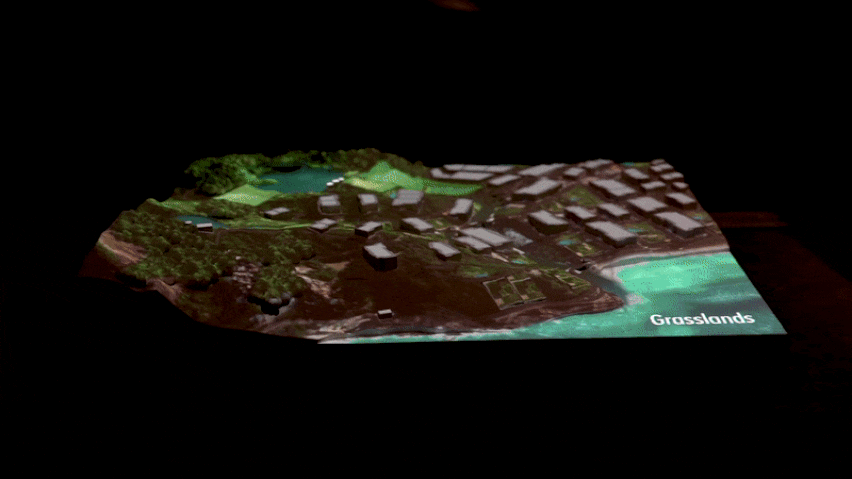 The third concept looks at cooperative local water management
The third concept looks at cooperative local water management
To select the building techniques presented in the installations and establish relationships with the different communities, Mordak worked with Julia Watson, author of the much-publicised book LO–TEK Design by Radical Indigenism.
The installation forms an attempt at finding practical applications for some of the indigenous technologies outlined in the book within a dense urban environment.
"If we did a bit more work, you could build the concepts," Mordak said. "They're all intended to be completely realisable."
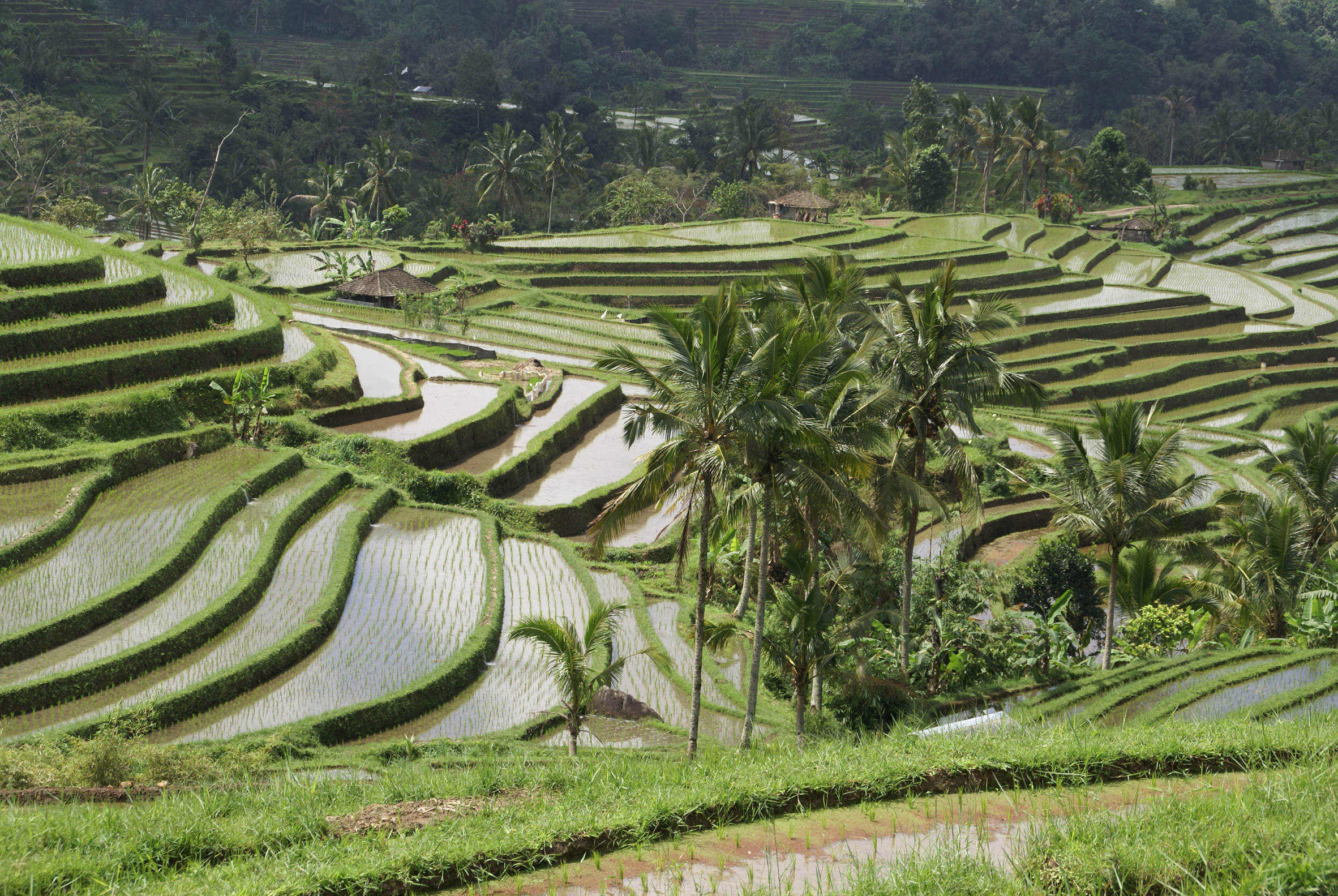 The idea is based on the Subak system for irrigating rice terraces. Image courtesy of Julia Watson
The idea is based on the Subak system for irrigating rice terraces. Image courtesy of Julia Watson
Alongside the concepts, Mordak and Watson also formulated a "smart oath", recorded on a public blockchain to set out how any kind of profits made from these ideas will be shared with the relevant communities.
"The project has been about how can we facilitate a fair and just knowledge exchange between ourselves, the engineers and landscape architects and architects, and the indigenous communities and the builders of these indigenous technologies," Mordak explained.
"If you're getting a bunch of design fees and you're using these ideas, these indigenous communities should be remunerated for their contribution. If we're not very clear about the way in which that should happen, then they could be exploited very easily."
All images are courtesy of Buro Happold unless otherwise stated.
Our Time on Earth takes place at London's Barbican until 29 August 2022. SeeDezeen Events Guide for an up-to-date list of architecture and design events taking place around the world.
The post Buro Happold works with indigenous builders to develop climate resilience strategies for cities appeared first on Dezeen.
#all #architecture #installations #landscapeandurbanism #conceptualarchitecture #burohappold #urbandesign #cities #climatechange